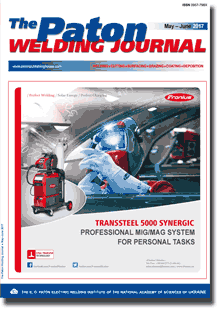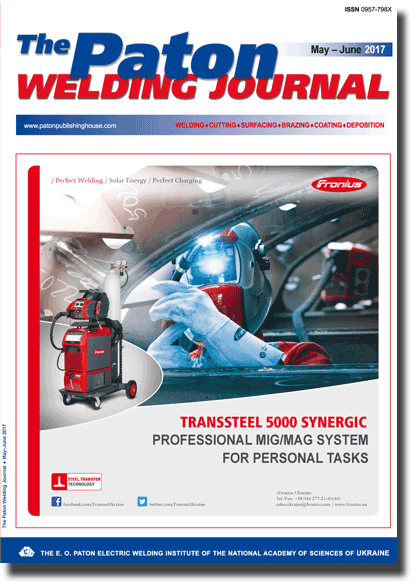| 2017 №06 (07) |
DOI of Article 10.15407/tpwj2017.06.08 |
2017 №06 (09) |

The Paton Welding Journal, 2017, #5-6, 37-44 pages
Technological Aspects of the Robotic TOPTIG Surfacing of Boiler Steel Tubes Using Alloy Inconel 625
T. Pfeifer1, M. Rozanski1, W. Grobosz1, J. Rykala1 and I.A. Riabcew2
1Instytut Spawalnictwa w Gliwicach Poland, 44–100. Gliwice, ul. Bl. Czeslawa 16–18. E-mail: is@is.gliwice.pl
2E.O. Paton Electric Welding Institute, NASU 11 Kazimir Malevich Str., 03680, Kiev, Ukraine. E-mail: office@paton.kiev.ua
Abstract
The research aimed to develop technological parameters of the TOPTIG method-based surfacing (using alloy Inconel 625) of boiler tubes (O 45?5) made of steel 13CrMo4–5 ensuring the obtainment of the iron content on the overlay weld surface below 5 %. The research resulted in the development of sets of parameters enabling the obtainment of overlay welds characterised by very high quality and the minimum degree of the stirring of the overlay weld metal with the base material. The above named sets of parameters were utilised when making a number of overlay welds on tubes. The research involved macroscopic metallographic tests of overlay welds, the identification of the base material content in the overlay weld, the determination of the chemical composition of the overlay weld surface as well as the performance of microscopic metallographic tests and the microanalysis of the chemical composition. It was ascertained that the TOPTIG technology enabled the making of overlay welds characterised by very high quality and the minimum degree of the stirring of the overlay weld metal with the base material (only 3.28 %) and made it possible to obtain an iron content of 2.75 % on the overlay weld surface using forced cooling performed inside the tube. Surfacing without cooling led to a significantly higher base material content in the overlay weld (approximately 14 %), where the content of iron on the overlay weld surface amounted to 8.47 %. 13 Ref., 3 Tables, 8 Figures.
Keywords: robotic surfacing, TOPTIG method, alloy Inconel 625, boiler tubes, waste incineration boilers, Fe content on the overlay weld surface
Received: 14.04.17
Published: 06.07.17
References
- Rozmus-Gornikowska M. (2014) Badania mikrostruktury i mikrosegregacji skladu chemicznego warstw ze stopu Inconel 625 napawanych technika CMT na podloze ze stali 16Mo3. Przeglad Spawalnictwa., 12, 4–8.
- Rutzinger B. (2012) Kierunki rozwoju w przemysle energetycznym. Zastosowanie napawania metoda CMT w elektrowniach weglowych. Biuletyn Instytutu Spawalnictwa, 5, 63–66.
- Rutzinger B. (2014) Wplyw procesu napawania na stopien wymieszania napoiny wykonanej spoiwem ERNiCrMo-3 (stop typu 625) na podlozu ze stali niestopowej. Ibid., 5, 72–74.
- Adamiec P., Adamiec J. (2006) Aspekty napawania stopami Inconel 625 i 686 elementow w kotlach do spalania odpadow. Przeglad Spawalnictwa, 5/6, 11–14.
- Nowacki J., Wypych A. (2010) Mikrostruktura i odpornosc na wysokotemperaturowe utlenianie napoin nadstopu Inconel 625 na stali Biuletyn Instytutu Spawalnictwa, 5, 84–87.
- Jarosinski J., Blaszczyk M., Tasak E. (2007) Napawanie stali stosowanych w energetyce stopami na osnowie niklu. Przeglad Spawalnictwa, 1, 30–33.
- Jarosinski J., Blaszczyk M. (2006) Napawanie stali stoso-wanych w energetyce stopami na osnowie niklu. Problem praktycznego pomiaru zawartosci zelaza. Spajanie, 2, 18–23.
- Abioye T.E., McCartney D.G., Clare A.T. (2015) Laser cladding of Inconel 625 wire for corrosion protection. Journal of Materials Processing Technology, 217, 232–240. https://doi.org/10.1016/j.jmatprotec.2014.10.024
- Abioye T.E., Folkes J., Clare A.T. (2013) A parametric study of Inconel 625 wire laser deposition. Mater. Proc.Technology, 213, 2145–2151. https://doi.org/10.1016/j.jmatprotec.2013.06.007
- Pfeifer T., Winiowski A. (2014) Badania procesu napawania i spawania plazmowego oraz badanie procesow dyfuzyjnego lutowania i lutospawania polaczen roznoimiennych metali lekkich. Praca badawcza Instytutu Spawalnictwa Cf-93 (ST-333).
- Pfeifer T. (2015) Opracowanie technologii napawania plazmowego proszkiem o skladzie stopu Inconel 625. Praca badawcza Instytutu Spawalnictwa Cf-94.
- Gladky, P.V., Pereplyotchikov, E.F., Ryabtsev, I.A. (2007) Plasma surfacing. Kiev: Ekotekhnologiya.
- Ryabtsev, I.A., Senchenkov, I.K., Turyk, E.V. (2015) Materials, technologies, mathematical modeling. Gliwice, Poland: SPI.
Suggested Citation
T. Pfeifer, M. Rozanski, W. Grobosz, J. Rykala and I.A. Riabcew (2017) Technological Aspects of the Robotic TOPTIG Surfacing of Boiler Steel Tubes Using Alloy Inconel 625. The Paton Welding J., 06, 37-44.The cost of subscription/purchase order journals or individual articles
| Journal/Currency | Annual Set | 1 issue printed |
1 issue |
one article |
| TPWJ/USD | 384 $ | 32 $ | 26 $ | 13 $ |
| TPWJ/EUR | 348 € | 29 € | 24 € | 12 € |
| TPWJ/UAH | 7200 UAH | 600 UAH | 600 UAH | 280 UAH |
| AS/UAH | 1800 UAH | 300 UAH | 300 UAH | 150 UAH |
| AS/USD | 192 $ | 32 $ | 26 $ | 13 $ |
| AS/EUR | 180 € | 30 € | 25 € | 12 € |
| SEM/UAH | 1200 UAH | 300 UAH | 300 UAH | 150 UAH |
| SEM/USD | 128 $ | 32 $ | 26 $ | 13 $ |
| SEM/EUR | 120 € | 30 € | 25 € | 12 € |
| TDNK/UAH | 1200 UAH | 300 UAH | 300 UAH | 150 UAH |
| TDNK/USD | 128 $ | 32 $ | 26 $ | 13 $ |
| TDNK/EUR | 120 € | 30 € | 25 € | 15 € |
AS = «Automatic Welding» - 6 issues per year;
TPWJ = «PATON WELDING JOURNAL» - 12 issues per year;
SEM = «Electrometallurgy Today» - 4 issues per year;
TDNK = «Technical Diagnostics and Non-Destructive Testing» - 4 issues per year.


